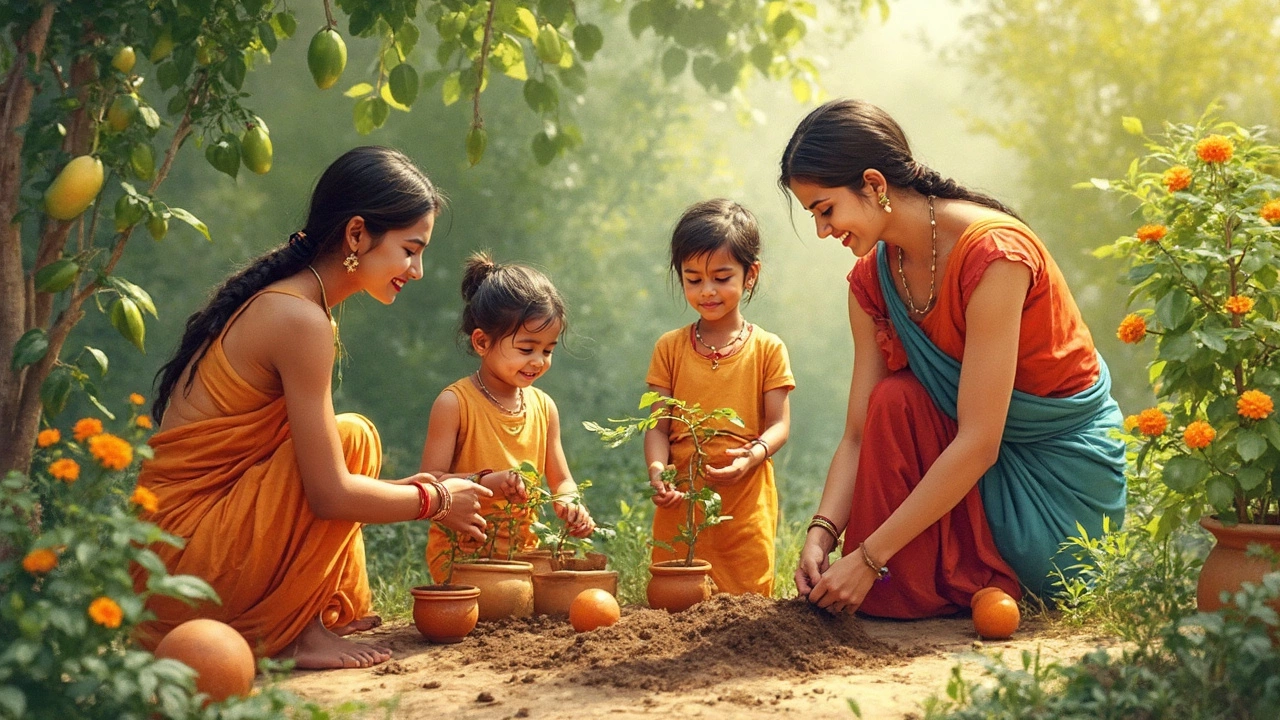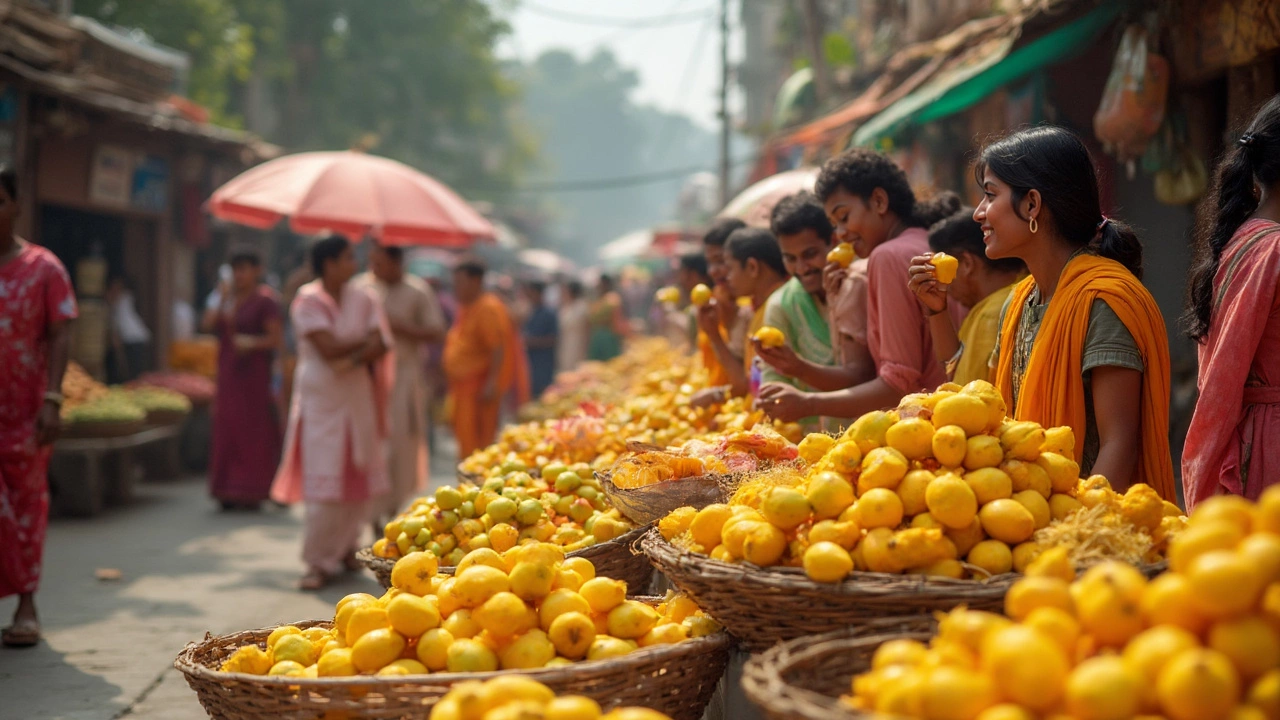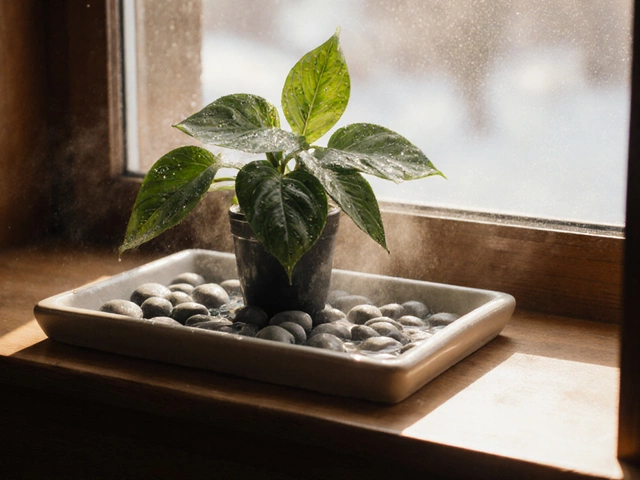The mango isn’t just popular in India—it’s the king of fruits here. People talk about mangoes with the kind of pride some reserve for family. It’s no shock the government put it right at the top of the fruit list. Walk through any city or village during summer, and you’ll spot street vendors selling fresh mango slices or families bonding over homemade aamras (that’s mango pulp, usually eaten with puris or roti).
If you think mango is only about flavor, you’re missing the bigger picture. This fruit blends into tradition, local lore, art, and even religious rituals. And for anybody interested in gardening—growing a mango tree at home isn’t as out of reach as it sounds. With the right spot and some patience, you can go from seed to fruit-bearing tree, even in a regular backyard.
- Why the Mango is India's National Fruit
- Different Varieties Grown Across India
- How Mango Shapes Daily Life and Traditions
- Tips for Growing Mango Trees at Home
- How to Spot a Perfect Mango
- Fun Mango Facts You’ll Want to Share
Why the Mango is India's National Fruit
Mango isn’t just a fruit in India—it’s part of people’s identities. Known as the India's national fruit, the mango earned this title because of its deep roots in Indian history, agriculture, and everyday life. This isn’t about hype; it’s backed by numbers and tradition.
Check this out: India alone produces over 40% of the world’s mangoes. That’s about 20 million tons each year, making it the world’s top mango producer by a huge lead. You’d be hard-pressed to find any other fruit with that kind of influence. Don’t just take my word for it:
"The mango holds a unique place in the hearts of Indians, celebrated in poetry and culture for centuries." — National Horticulture Board of India
So why did the government officially dub mango as the country’s national fruit?
- Historical legacy: Mango trees have grown in India for over 4,000 years. Ancient texts like the Vedas and Upanishads mention them.
- Cultural impact: You’ll see mango leaves in wedding decorations, religious rituals, and even hung above doorways for good luck.
- Economic importance: Mango farming provides jobs for millions—from orchard owners to street sellers.
- Culinary love: From ripe Alphonso to tangy raw Kairi, mango is a summer essential in every Indian kitchen.
Quick stats on just how big a deal mango is in India:
| Fact | Details |
|---|---|
| India’s Share in Global Mango Production | 40%+ |
| Mango Varieties in India | Over 1,000 types |
| Annual Production (2024) | 20 million tons |
| Major Mango States | Uttar Pradesh, Andhra Pradesh, Maharashtra, Karnataka |
It’s hard to walk through any street or market in summer and not bump into mangoes. For a lot of folks, the taste and memory of mango season sticks for life. That’s how a fruit becomes more than just food—it’s a symbol of the country itself.
Different Varieties Grown Across India
India isn’t just the world’s biggest producer of mangoes. It’s also home to over a thousand mango varieties. But only a few get most of the attention in markets and home gardens. Each region has its local stars, and people get pretty loyal about which one’s best.
If you’ve ever tasted an Alphonso, you know why it’s sometimes called the 'King of Mangoes.' This variety comes from Maharashtra, especially Ratnagiri. Alphonso is famous for being super sweet, creamy, and not too fibrous. For a lot of folks, this is the gold standard of mango flavor in India.
Down in Andhra Pradesh and Telangana, there’s the Banganapalli mango. These guys are big, smooth-skinned, and mild-flavored—great for eating fresh or making juice. If you’re up in Uttar Pradesh, you can’t miss the Dasheri mango. Small, greenish, and with a thin seed, Dasheri mangoes are perfect for snacking off the peel.
Another well-known one is the Kesar mango from Gujarat. Most people love Kesar for its deep orange color and rich aroma, which makes it a regular in desserts and shakes. Then there’s Himsagar from West Bengal—juicy, fibreless, and in-demand for just a short time each year.
Even in the south, the Neelum and Totapuri mangoes are easy to spot. Totapuri’s odd, beaky shape means you can recognize it in almost any fruit shop. Its tangy taste makes it the go-to for mango pickles.
If you’re thinking about planting India's national fruit at home, the type you choose matters. Some trees, like Alphonso or Kesar, do better in certain regions because of the weather and soil. You’ll want to ask at a local plant nursery which variety suits your area best.
- Alphonso: creamy, sweet, mostly from Maharashtra
- Banganapalli: firm, mild, popular in Andhra Pradesh/Telangana
- Kesar: bright orange, rich smell, key in Gujarat
- Dasheri: soft, sweet, common in the north
- Himsagar: juicy, fibreless, best in West Bengal
- Totapuri: tangy, hardy, used for pickles in the south
Each type has its own fan following, and you’ll find local markets heaving with excitement when these seasonal favorites hit their peak. Trying different varieties is part of the fun—don’t settle for just one kind if you can help it. Every region’s mango has its own personality.
How Mango Shapes Daily Life and Traditions
The mango isn’t just a summer treat; it’s all over Indian culture. Every year when mango season rolls in, folks host mango parties, share boxes with neighbors, and even send them as gifts to relatives far away. If you get a big basket of mangoes at work, it’s not just a tasty perk—it means someone really values you.
Mango leaves are used for decoration at weddings, housewarming parties, and festivals like Diwali. You’ll see strings of fresh mango leaves, known as 'toran', hung above doors. This isn’t just for show—it’s meant to bring good luck and keep away bad vibes.
Mangoes pop up in religious rituals too. In Hindu pujas, people sometimes place an entire mango or use the leaves while offering water to gods and ancestors. Mango wood is even used for making ritual fire because it’s considered pure.
If you’re ever invited to someone’s home in summer, don’t be surprised if most desserts have mango in them. Dishes like aamras, mango lassi, and mango pickle are everyday stuff in many Indian homes, especially when the best varieties hit the markets.
Here’s how India's national fruit shows up in daily life:
- You’ll find paintings, stamps, and even currency notes featuring the mango.
- Kids play games with green mangoes, trying to knock them down from trees with sticks or stones.
- In rural areas, whole communities work together during mango harvest, turning picking into a social event.
- Mango season is also when local markets buzz with activity, as people hunt for their favorite types by smell and feel.
The bottom line—mango’s a lot more than just something you eat. It’s deep in the social and spiritual side of life, shaping how people connect and celebrate.

Tips for Growing Mango Trees at Home
Getting a mango tree going in your own backyard? It’s actually easier than most people think. The India's national fruit is pretty tough once it gets past the baby stage, but the first couple of years need a bit of extra care.
First off, pick a spot with loads of sunlight. Mango trees hate the shade. If you’re planting more than one, give them at least 8-10 feet of space so they don’t fight for sun and air. Mangoes do well in most soils, but they really thrive in sandy loam with good drainage—don’t let their roots drown, or you’re asking for trouble.
- Seed or sapling? Saplings are the safer bet if you want fruit faster—usually 3-5 years to start. Grown from seed, it can be 6-8 years, and the results can be unpredictable.
- Watering: Young trees do need regular watering, but don’t overdo it. Aim for once a week, unless it’s scorching out. Mature trees are surprisingly drought-resistant.
- Fertilizing: Right after planting, skip the fertilizer for a couple months. Then, give them a balanced fertilizer every season—use less in winter, more when the tree is growing (spring and monsoon).
- Pruning: Keep your tree in shape by trimming off dead or tangled branches. This stops pests and keeps the shape manageable for a home garden.
- Mulching: A layer of old leaves or grass at the base helps keep the soil moist and stops weeds from taking over.
Different regions will see mango trees grow at different speeds because of climate. Here’s what you can usually expect, based on Indian states and average time till fruit:
| State/Region | Common Mango Variety | Avg. Years to Fruit |
|---|---|---|
| Uttar Pradesh | Dasheri | 4-6 |
| Maharashtra | Alphonso | 5-7 |
| West Bengal | Himsagar | 4-6 |
| Andhra Pradesh | Banganapalli | 3-5 |
Watch out for common problems like mealybugs and anthracnose. Both can mess up your crop. Neem oil spray works on most pests and is safe for edible plants. If the leaves look black and spotty, trim affected branches and don’t let water collect on leaves for too long.
Avoid using chemical-heavy solutions, especially if you’ve got pets like my dog Max sniffing around. Organic methods cost less and work just fine for home growers.
How to Spot a Perfect Mango
If you’ve ever stood in front of a mango stall, feeling totally lost, you’re not alone. Picking a top-quality mango isn’t rocket science, but there are a few things to keep in mind so you don’t go home with a dud, especially if you want to enjoy the real flavor of India's national fruit.
First, skip the “hard equals unripe” myth. Not every mango goes soft when ripe; some varieties like Alphonso stay firm even when they’re peak sweet. Instead, focus on these basic steps:
- Color isn’t everything: It depends on the variety. Alphonso mangos turn golden with a bit of green, while Kesar is yellow-orange. Don’t stress if you see green patches—they don’t always mean unripe.
- Squeeze gently: A ripe mango gives just a little under light pressure, sort of like a ripe avocado. If it feels rock-hard or super mushy, put it back.
- Give it a sniff: The stem end should smell sweet and fruity. No scent usually means it’s not ready, and anything sour or fermented means it’s likely gone bad.
- Check the skin: Small blemishes are fine, but stay away from big black spots, shriveled skin, or obvious damage. Wrinkles aren’t always bad—they often show a mango is sweet and juicy.
- Look for sap: Sometimes a drop of sticky liquid at the stem is a good sign. That usually means the fruit is fresh.
One last tip: don’t get lured by size. The biggest mango isn’t always the best. Each type has its own “normal” size, so compare with others of the same variety. Ask the seller what’s fresh that day—chances are, they’ll steer you right. After a little practice, you’ll know exactly which ones to grab and which ones to leave alone.
Fun Mango Facts You’ll Want to Share
Mango is more than just a summer snack. From massive exports to wild records, this juicy fruit is loaded with stories you can drop in any conversation.
- India grows more mangoes than any other country in the world—about 40% of the globe’s total crop.
- There are over 1,000 mango varieties in India alone! Each state seems to claim “the best,” from Alphonso in Maharashtra to Dasheri in Uttar Pradesh.
- The Guinness World Record for the heaviest mango was set in the Philippines at 4.25 kg, but ordinary Indian mangoes average around 200-400 grams each.
- “Mango season” isn’t nationwide at the same time. It starts as early as March in South India and stretches to August in the North, so you’re never too far from a fresh bite if you travel countrywide.
- The word 'mango' is thought to come from the Tamil word 'mangai.' When Portuguese traders arrived in the 15th century, they turned ‘mangai’ into ‘manga,’ which influenced the English name.
Beyond eating, mango leaves get used at weddings and festivals—tied over doorways for good luck. And if you spot students chewing mango leaves before an exam, it’s an old trick thought to help with memory (though science is shaky on that one).
Export numbers are wild, too. Check out this simple breakdown of India’s recent mango exports:
| Year | Export Volume (Metric Tons) | Main Destinations |
|---|---|---|
| 2022 | 21,033 | UAE, UK, Qatar |
| 2023 | 23,900 | UAE, USA, Saudi Arabia |
| 2024 | 24,760 | UAE, USA, Oman |
So next time you eat a mango, remember, it isn’t just a fruit—it’s kind of a superstar. The India's national fruit tag isn’t for nothing.





